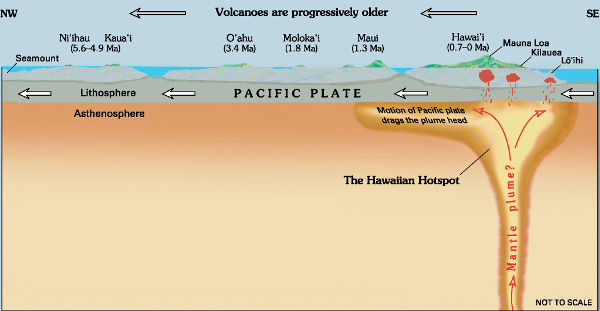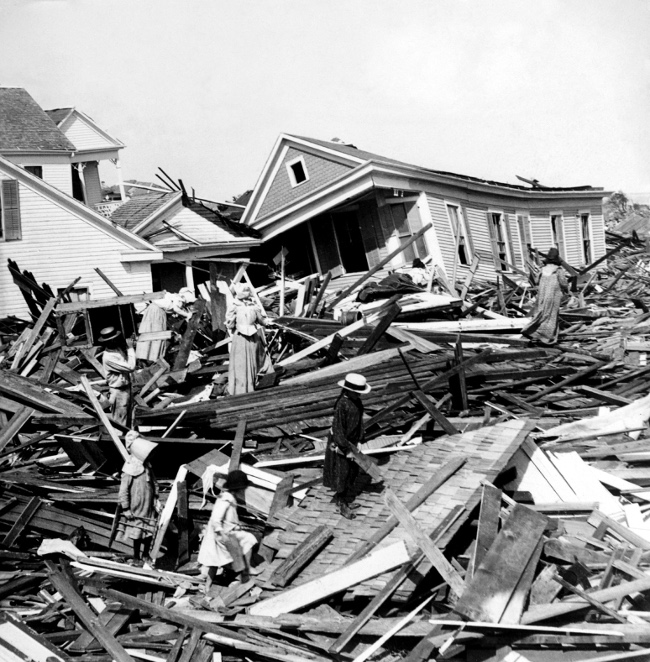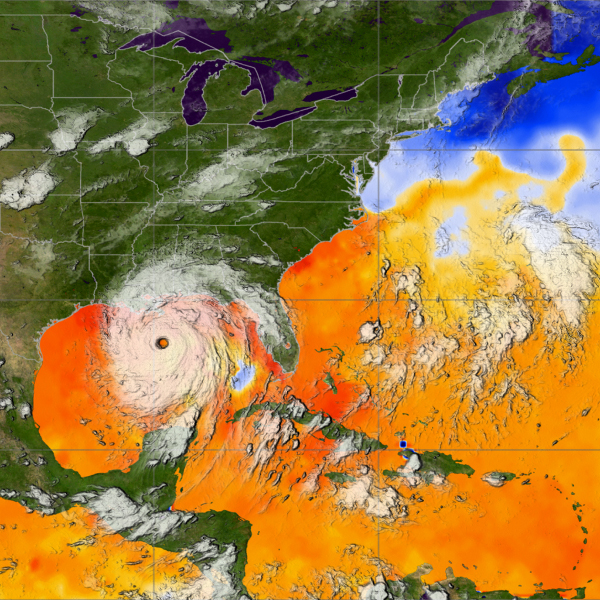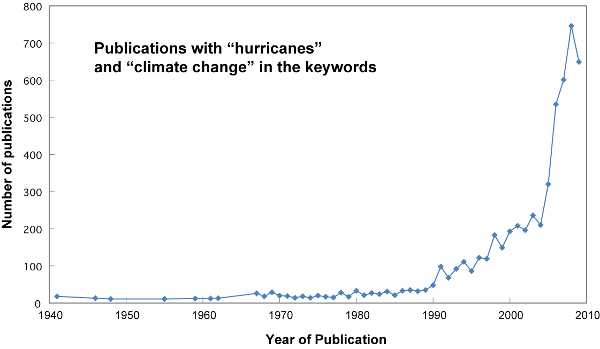Indeas in Science
Scientific controversy
Did you know?
Did you know that science is full of controversy? And that controversy in science can be a good thing? A scientific controversy is more than a disagreement between scientists. In fact, controversies are found in all scientific fields and usually lead to progress in science.

The first offshore oil well out-of-sight from land was drilled in 1947 by the Kerr-McGee Corporation, off the coast of Louisiana (see Figure 1). Within a few years, there were a dozen such wells in the Gulf of Mexico, followed by wells drilled off of the coast of California and other locations. In the early 1950s, the United States government passed legislation that gave the federal government jurisdiction over the submerged continental shelf, and allowed the Department of the Interior to lease these areas for mineral development. By the late 1950s, these offshore oil leases were one of the largest revenue generators in the United States, second only to income taxes (Freudenburg and Gramling, 1994).
On January 28, 1969, just as oil workers completed the fifth well on an offshore platform off the coast of Santa Barbara, a blowout occurred that would eventually spill millions of gallons of oil into the water, soil popular beaches, and bring the previously out-of-sight drilling practice back into view. A process that had previously seemed to have largely positive effects – revenue generation for the government and a domestic source of energy – now had visible detrimental effects: Local beaches were blackened by oil, dead and dying seabirds littered the area, and scores of coastal communities reeked with the stench of oil.
On March 21, President Nixon visited the spill and told the assembled crowd of residents and reporters that he would consider a ban on offshore drilling and would convert the area into a permanent ecological preserve. But the ban was lifted on April 1, angering local residents and sparking a controversy over the merits of offshore drilling. Were the benefits worth the risks? Some felt that having a reliable source of domestic oil provided security for the country, and outweighed environmental concerns. Others cited the toxic effects of oil spills on fisheries, tourism, and the environment in general as a reason to shut down offshore drilling. The government placed some coastal areas off-limits to drilling, such as the Arctic National Wildlife Refuge, while in other regions, such as the Gulf of Mexico, drilling moved further and further offshore into deeper water.
A massive blow-out from one of these wells in April 2010 reinvigorated the controversy over whether or not offshore drilling should be allowed and how it should be regulated. People on all sides of the controversy are using different data as evidence to support their position: a decline in shrimp fishing industry, lax regulation of drilling companies, domestic security and the need for energy resources, the interaction between hurricanes and surface oil. Though it is unlikely that the controversy will ever be resolved to the point where everyone agrees, additional legislation and regulations put in place by the government will determine the future of offshore drilling.
Science is also full of controversy. Similar to the controversy over offshore drilling, scientists appeal to evidence to support their claims, and the nature of the debate changes as new evidence comes to light. But there are some key differences between a scientific controversy and other types of controversy. For example, many people think that the controversy over offshore drilling is holding up progress, whether that progress is economic, environmental, or political. In contrast, a controversy in science often creates progress because it spurs new research and therefore is an essential part of the process of science.
What is scientific controversy?
Scientists can disagree about lots of things, from the mundane (like what is the best kind of analytical instrument to use) to the profound (whether or not string theory, a recently developed theory in physics, is an accurate representation of reality). Two scientists disagreeing over an instrument or string theory – or even the interpretation of data – does not count as a controversy, however. A true scientific controversy involves a sustained debate within the broader scientific community (McMullin, 1987). In other words, a significant number of people must be actively engaged in research that addresses the controversy over time. No matter what the content of the disagreement, the scientists involved all share some fundamental knowledge and agree that the subject matter is worth being concerned about and that the various arguments are legitimate.
What makes the arguments legitimate is that they are based on data. It is not enough for scientists to simply say, “I don’t agree with you.” Instead, they must conduct the research to garner enough evidence to support their claim. An argument must explain the majority of data available – not just the data collected to support one side. This is not necessarily the case in public controversies such as that over offshore drilling, where a group or individual can decide that some data are more important than other data – the number of birds that died or the economic impact of drilling or the percentage of oil imports. In a scientific controversy, all of the data must be explained and taken into account.
Though controversies are often discussed in informal settings (the same way you might discuss a controversial issue with your friends), the real debate is carried out at research meetings and through the publication of journal articles (see our Scientific Journal Articles module). It is only through this process that the debate becomes part of the scientific literature (see our Utilizing the Scientific Literature module) and helps science progress. There is no authoritative body in science that decides what the right answer in a controversy is, nor does it require complete consensus among all scientists. The resolution to a controversy comes when one argument is widely accepted and other arguments fade away. Often, the evidence in favor of one side of the controversy becomes so overwhelming that people simply stop arguing about it. Usually, that happens when multiple lines of evidence coming from multiple research methods (and perhaps multiple disciplines) all converge.
Controversies are ongoing in every field of science on a regular basis. For example, as of 2010, geophysicists are engaged in a debate about the existence of mantle plumes, thin columns of hot rock that rise from the Earth’s core to the surface and cause volcanic activity (see, for example, Kerr, 2010). The concept of a mantle plume as a non-moving source of magma for island chains like Hawaii (Figure 2) was first postulated by J. Tuzo Wilson shortly after the development of the theory of plate tectonics (see our Plate Tectonics I module) and was widely accepted over the next thirty years. In 2003, however, a group of scientists led by John Tarduno, a geophysicist at the University of Rochester, presented strong evidence that the mantle plume thought to be responsible for forming the Hawaiian islands had moved more than 1000 km over time (Tarduno et al., 2003). That paper launched a multitude of additional studies that began to question the very existence of mantle plumes. The ongoing debate has been heated at times, but has also caused a tremendous leap in our understanding of the volcanic processes associated with mantle plumes, and our scientific knowledge has advanced.

The debate over the existence of mantle plumes is clearly a scientific controversy, and most scientific controversies similarly have little to do with personal, ethical, or political controversies. On the other end of the spectrum, the controversy about the use of stem cells harvested from human embryos in biomedical research is not a scientific controversy – scientists agree about what stem cells are and how they work. Instead, the controversy revolves around whether or not it is ethical to use stem cells. Sometimes, however, the lines between scientific controversy and other kinds of controversy get blurred. Scientists are human, after all, and what starts as a scientific controversy may also include personal disagreements (see our Scientists and the Scientific Community module). In other cases, the media may exaggerate a scientific controversy and turn it into a political debate. One example of this kind of blurring of the lines is the study of the relationship between hurricanes and climate change.
Comprehension Checkpoint
A scientific controversy ends when
(A)__all scientists come to an agreement on a resolution.
(B)__evidence in support of one side of the controversy becomes convincing.
Development and resolution of a scientific controversy: Will global warming increase hurricanes?
On his second voyage, the explorer Christopher Columbus encountered a storm while on the island of Hispaniola in 1494: "Eyes never beheld the seas so high, angry, and covered by foam," he wrote in a letter to his benefactor, Queen Isabella. "Never did the sky look more terrible; for one whole day and night it blazed like a furnace. The flashes came with such fury and frightfulness that we all thought the ships would be blasted. All this time, the water never ceased to fall from the sky" (Barnes and Lyons, 2007). Though this was, perhaps, a new experience for Columbus, the storms were well known to the Caribbean locals, who called them furacano, a word that became common in English around 1650 as hurricane. Columbus wrote the first account of a hurricane in the Atlantic (Millás and Pardue, 1968), but there were many more to come.
Throughout the 1800s, hurricanes were observed and described. Early on, several observers noted that these storms were vortices, rotating in a counter-clockwise direction. By the middle part of the century, weather observatories had been established in many locations in North America, and some scientists were recording hurricane tracks. After a major hurricane struck the city of Galveston, Texas, in 1900, killing at least 8,000 people (see Figure 3), analysis of these observations took on a new urgency.

Many of the earliest studies of hurricanes, also called tropical cyclones (or typhoons in the Pacific Ocean), were carried out by scientists who had studied with Vilhelm Bjerknes, a physicist who had determined the equations that govern circulation in the atmosphere (see our Modeling in Scientific Research module for more information). In 1917, Bjerknes started the Bergen School of Meteorology in Bergen, Norway, bringing together a group of well-known and accomplished meteorologists (Liljequist, 1980). Their initial research focus was on cyclonic weather systems in the temperate zones, the latitude of most of Europe.
A new research direction: Water temperature and hurricanes
By 1928, the group felt that their methods and understanding of these systems were mature, and could be applied to rarer and more complicated storm systems – tropical cyclones (Bergeron, 1954). Erik Palmén, a Finnish meteorologist who moved to Chicago after his time at Bergen, recognized that hurricanes formed only above sea water that was warmer than 26–27° C (~80° F), a critically important observation that he published in 1948 (Palmén, 1948). His publication included a map of sea surface temperature during the warmest part of the year – called "hurricane season" – with arrows showing the tracks of major hurricanes (see Figure 4). All of the arrows began in a narrow band of the ocean where water temperatures were highest.

Sea surface temperature is one manifestation of climate. As global climate changes, the distribution of warmer and colder waters on the sea surface also changes. Tor Bergeron, another member of the Bergen group, went beyond thinking about how sea surface temperature changes annually and considered what happened over longer periods of time, placing hurricanes in the context of long-term climate changes. In a review paper in 1954, Bergeron speculated that the frequency and intensity of hurricanes, as well as where and when they formed, could have changed dramatically over geologic time with small changes in Earth's orbit and solar intensity – both of which affect global climate (Bergeron, 1954). He urged scientists who studied climate in the past to keep that in mind. At the time, however, the techniques available to assess past climate to the level of detail of individual hurricanes simply didn't exist, and few scientists took up the challenge.
New data fuels controbersy: Climate change and hurricanes
Starting in the 1980s, however, this idea re-emerged as scientists began to see variability in the frequency and intensity of hurricanes that correlated well with short-term climatic cycles that operate on the order of 10-12 years, like the El Niño-Southern Oscillation (ENSO) in the tropical Pacific. El Niño is familiar to many people around the world for its effects on local weather patterns, but now there was evidence showing that this cycle in the tropical Pacific affected hurricane generation in the Atlantic Ocean (Gray, 1984). At the same time, more and more scientists began to recognize that global sea surface temperatures were steadily rising as the climate warmed, and they began to explore the links between how global warming would affect both the climatic cycles and hurricane formation (Emanuel, 2003). Most who studied the phenomena found that sea surface temperature changes of the magnitude they were seeing would, indeed, influence hurricane formation, but not nearly as much as natural variability within the climatic cycles.
That general sentiment began to be questioned, however, as more data came in. In June of 2005, Kevin Trenberth, a climate scientist at the National Center for Atmospheric Research (NCAR), published a short article in Science entitled "Uncertainty in Hurricanes and Global Warming" (Trenberth, 2005). In it, he stated:
During the 2004 hurricane season in the North Atlantic, an unprecedented four hurricanes hit Florida; during the same season in the Pacific, 10 tropical cyclones or typhoons hit Japan (the previous record was six). Some scientists say that this increase is related to global warming; others say that it is not. Can a trend in hurricane activity in the North Atlantic be detected? Can any such trend be attributed to human activity? Are we even asking the right questions?
Trenberth was highlighting a controversy that was just beginning to develop at the time, pointing out that we did not yet have enough data or enough theoretical understanding of the process to make valid, reliable interpretations. His questions inspired several other scientists to analyze the available data, searching for trends (see our Data Analysis and Interpretation module for more information on this process) and to begin new research into the issue. Among those was a group of four atmospheric scientists, three from the Georgia Institute of Technology and one from NCAR. They worked through the early part of the summer and submitted their work for publication in August 2005.
Hurricane Katrina: Scientific controversy goes public
Prior to publication, however, a dramatic and pertinent event occurred: on Monday, August 29, 2005, Hurricane Katrina made landfall near New Orleans, Louisiana (Figure 5). The hurricane brought with it widespread physical destruction and loss of life, and created a social, political, and economic crisis. Within hours of landfall, however, a question arose in the media: Was this particularly destructive hurricane caused by global warming? While this was not a scientific question or one that could be answered through research, it brought the public into the scientific controversy about the relationship between climate change and hurricanes.

A little over two weeks later, on September 16, the work by the scientists at Georgia Tech and NCAR was published in Science. Their analysis showed that, although the number of total hurricanes had not increased significantly since 1970, the proportion of hurricanes that were category-4 and -5, the strongest storms, had (Webster et al., 2005). In other words, they concluded that there had been more intense hurricanes, even though the total number had not changed. They correlated these changes with an increase in global sea-surface temperature (SST), which had been steadily rising as global atmospheric temperatures increased. In a very general way, the work by Webster and colleagues implied that there could be more hurricanes like Katrina in the future.
Social and plitical implications of scientific controversy
The results of their work had significant social and political implications: If global warming caused more intense hurricanes, there would be additional reason to take action to reduce the magnitude of warming in order to reduce destruction. As a result, the authors of the article received an unusually high number of responses to their work, both responses from scientists that are typical of scientific publications and letters, and personal responses from the general public. In an article published in the Bulletin of the American Meteorological Society the following year, three of the original four authors reported on those responses (Curry et al., 2006). Some of the comments they received were valid scientific arguments, but unfortunately, that was not always the case. Many of the comments were based in political and social concerns, and some involved personal attacks on the scientists.
For example, one of the frequent comments that the authors received is that they weren't qualified to analyze the hurricane data, despite the fact that the researchers were all atmospheric scientists who had been working on similar types of climate data for decades (Curry et al., 2006). This type of personal attack can be damaging and create controversy in the media, but it is not a component of the scientific controversy. Of course, scientists are people, and any public debate involves differences in personality and opinion, but those personal differences are not based on the data.
In contrast, some of the points raised in response to the article had a valid scientific basis. For example, one of these more substantial arguments centered on the reliability of the early part of the hurricane record. Accurate, worldwide tracking of hurricanes is a relatively recent phenomenon that only became easy with satellites, starting in the 1970s. Aircraft started recording hurricanes in the mid-1940s, but the data were limited to common flight lines over the oceans. Prior to that, the majority of observations about hurricanes were made from land, and even that record only goes back to 1851. Given that hurricanes spend most of their time over the ocean, this meant that the data could be inaccurate and thus difficult to interpret.
Comprehension Checkpoint
Scientific controversy can spur people to take action in society or pass legislation.
Scientific controversy spurs new research
Many scientists recognized that much more work was needed in order to make progress in our understanding. As a result, the number of studies addressing the relationship between global warming and hurricanes proliferated over the next few years (see Figure 6). Some scientists used detailed global climate models and found that natural, local climate variability seemed to have a greater effect on hurricane intensity than current global warming (Vecchi and Soden, 2007). Others reanalyzed older hurricane records to correct for systematic bias, removing some storms that were poorly constrained from the record and adding new ones (Landsea et al., 2008). Still others extended the record further back in time by collecting descriptions of independent records that did not rely on human observations (Mann et al., 2009). Throughout this process, scientists disagreed and debated what was really going on with hurricanes as Earth's climate warmed. Were they increasing in frequency? Intensity? No change? A NOVA documentary in 2006 pitted MIT scientist Kerry Emanuel against Chris Landsea, a meteorologist at the Miami Hurricane Center, suggesting that the two scientists had a fundamental disagreement about the nature of strong hurricanes (Public Broadcasting Service, 2006).

Within a few years, however, much of the disagreement had subsided. In 2010, the Expert Team on Climate Impacts on Tropical Cycles, a group of scientists assembled by the World Meteorological Organization (WMO), attempted to bring all of the new research together and summarize what scientists had learned since 2005. The team, which included both Kerry Emanuel and Chris Landsea, published an article in Nature Geoscience entitled "Tropical cyclones and climate change" (Knutson et al., 2010). In the abstract, they summarize the state of the scientific controversy:
Whether the characteristics of tropical cyclones have changed or will change in a warming climate – and if so, how – has been the subject of considerable investigation, often with conflicting results. Large amplitude fluctuations in the frequency and intensity of tropical cyclones greatly complicate both the detection of long-term trends and their attribution to rising levels of atmospheric greenhouse gases. Trend detection is further impeded by substantial limitations in the availability and quality of global historical records of tropical cyclones. Therefore, it remains uncertain whether past changes in tropical cyclone activity have exceeded the variability expected from natural causes. However, future projections based on theory and high-resolution dynamical models consistently indicate that greenhouse warming will cause the globally averaged intensity of tropical cyclones to shift towards stronger storms, with intensity increases of 2–11% by 2100. Existing modeling studies also consistently project decreases in the globally averaged frequency of tropical cyclones, by 6–34%.
In other words, the authors acknowledge the complexity of the issue, noting what aspects make it a difficult subject to study (large natural fluctuations, a limited historical dataset), and that these complexities have caused mixed results from different scientific studies. They also point out, however, where there is agreement: There is consistency in all of the models that predict more strong storms in the future as global climate changes. Their statement also emphasizes that science is a work in progress that relies on the creativity of scientists to overcome problems, and controversy is a natural outcome of that process.
This debate on the relationship between tropical storms and global warming fulfills the requirements for a scientific controversy – it involves a large number of scientists doing active research into the issue, and the debate took place (and continues to take place) in public, through a peer-reviewed process, over a sustained period of time. The nature of the subject under investigation meant that some social and political components were involved, but ultimately the scientific progress that was made was unrelated to a particular storm or situation.
Comprehension Checkpoint
Scientific controversy generally
The resolution of controversy
Does the publication of the article by the WMO team mean that the controversy is resolved? Well, yes and no. As stated in the article, most of the current evidence suggests that the occurrence of hurricanes will be affected by climate change, and the number of publications concerning the topic so far seems to have peaked in 2008 (see Figure 5). Other arguments have not faded away completely, however, and there will undoubtedly be more research in this field as new data are collected, the resolution and power of computer models increases, and as warming continues.
More complete resolution is possible, however, such as in the debate over plate tectonic theory that occurred in the 1960s, where the accumulated evidence became overwhelming in support of plate tectonics. In other cases, resolution awaits the development of a new technology or technique that can acquire the kind of data that can really address the question. For example, the definition of "race" in humans was the subject of significant study and controversy throughout much of human history, but it wasn't until the sequencing of the human genome that scientists were truly able to examine claims for a genetic basis for race and found none (Jorde and Wooding, 2004).
In most cases, controversy is a sign of health in the scientific endeavor, and the more people that are involved in the controversy, conducting research to address the issues, the more rapidly progress is made. Sometimes the scientists involved in a controversy are portrayed as rivals, similar to the environmentalists vs. the oil companies in the controversy over offshore drilling, but this is not an accurate portrayal. The "winner" in scientific controversies is not one side, but the entire scientific community.
Summary
Controversy is always a bad thing. It exists in every field of science and in many cases clarifies and advances our scientific understanding. This module explains what scientific controveries are and how they differ from other kinds of controversy. Using the example of climate change, the module identifies the factors that lead to controversies in science and explains how they are resolved.
Key Concepts
- A scientific controversy is a sustained, public debate among the broader scientific community in which arguments are based on evidence.
- Controversies cause progress in science by encouraging research on the topic in question.
- Controversies are resolved when the evidence overwhelmingly favors one argument.
- Scientific controversies are distinct from political, ethical, and personal controversies, though sometimes they overlap or can have complex interactions.
QUIZ
- In order for a scientific controversy to be resolved, which of the following is most likely to occur?
- Scientists contribute to scientific controversies primarily by
- Why did the World Meteorological Organization appoint an expert panel to write a paper about tropical cyclones?
- A valid argument in a scientific controversy must based on
- Controversies are rare in science.
- The Delta smelt is a minnow (a type of fish) that lives only in the estuary of the Sacramento River delta in California. The delta is also a source of drinking and agricultural water for California residents, and intake valves for pipelines are located near the breeding waters of the smelt. Scientists have determined that the smelt populations are in rapid decline and that they need more freshwater than is currently available to them after drinking water is pumped out. Nearby farmers argue that they need more freshwater to grow their crops, and regulatory agencies have faced criticisms from all sides on their management of the water resources. This a scientific controversy.
- Many large mammals went extinct in North America around 11,000 years ago, including the woolly mammoth and the mastodon. Based on archaeological evidence, some scientists have argued that hunting by humans, who were relatively new to the continent, caused the extinctions. Based on climate data, other scientists have argued that sudden warming that led to the melting of the ice sheets was the primary cause of the extinctions. In a number of recent studies, scientists have reported sequencing the woolly mammoth genome and running detailed climate models for the time period around the extinction, and new evidence is being discovered. This is a scientific controversy.
(A)__All scientists must agree on a resolution.
(B)__A vote is taken among insterested scientists.
(C)__Multiple lines of evidence favor one side.
(D)__Controversies are never really resolved.
(A)__publishing articles in newspapers.
(B)__discussions with individual scientists.
(D)__publishing in the peer-reviewed literature.
(A)__because so much new research have been done, it needed to be summaried.
(B)__to resolve the controversy about golbal warming and hurricanes.
(C)__because scientists couldn't agree on the answer.
(D)__to prevent more people from getting involved in the controversy.
(A)__personal disagreements between scientists.
(B)__explanations of all of the available data.
(C)__political and social implications of the research.
(D)__only the most recently collected data.